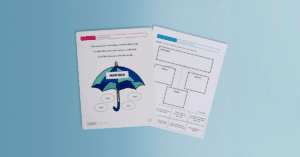One of the most common challenges with vocabulary intervention is selecting targets.
After all, there are hundreds of thousands of words to choose from! How do we narrow it down?
Last week, I shared four criteria for selecting vocabulary targets, but I thought it would be helpful to back up a bit.
How do we know which types of words to choose? Are we focusing on basic concepts, synonyms/antonyms, categories, Tier 2 words, context clues, affixes…? The list goes on and on!
Once we have a focus, what materials do we use? Do we work off of a word list? Do we use materials from the classroom?
The Answer to All of Your Questions
It depends.
And we don’t really have all of the answers yet.
Ack! I know! So frustrating!
What We Do Know
I’ve been sharing information in my vocabulary blog post series, and those are a great place to start for a general overview.
There are some suggestions in the literature (like Lowman, Stone, & Guo’s article), but there isn’t a road map. There is a good dose of clinical judgment involved when answering these types of questions for our students–even though it would be lovely to have a proven step-by-step guide, wouldn’t it?
Let’s look towards them for some inspiration…
They used interactive book reading to teach instructional verbs to preschoolers. Students in the intervention group were taught 12 words over the course of three weeks. Students in the control group were only exposed to the words during teacher talk.
The results? “Children in the book-reading group knew significantly more words on a receptive picture identification task than children in the control group both at posttesting and at follow-up testing in the fall. No significant group differences were noted at spring testing.”
(I found out about this study–and many others–from Meredith at the Informed SLP.)
Although the intervention didn’t have lasting effects, the students in the intervention group did gain an entire year of incidental learning in just three weeks! I can’t help but wonder what would have happened if the intervention continued… And how can we use this with other ages?
My Approach
Caveat: These are very general statements! My approach varies depending on the context, unique characteristics of the student, and countless other variables. The research isn’t there to tell me exactly what to do with all of my students, so I’ve integrated as much as I can and use clinical judgment to figure out the rest!
Across the board, I love using contextualized interventions. I’ve tried a more traditional drill approach, but I feel like I get a better result when I focus on the student’s context. This article by Gilliam, Gillam, and Reece (2012) gives a helpful overview with a sample lesson. They focused on narrative language skills in this particular study, but many of the principles can still apply. The Contextualized Language Intervention textbook (affiliate link) goes into a lot more detail! This approach makes a lot of sense to me, and that’s why I write so much about literacy- and curriculum-based therapy!
Early Communicators
PracticalAAC is a fabulous resource when it comes to figuring out where to start with emerging communicators! Core vocabulary can be a great approach, but it’s not the answer for all of our students.
Foundational Vocabulary
When I work with younger students, basic concepts are one of the first things I look at. They are one of the first things that I target because they’re key to developing more complex vocabulary and are a key part of the preschool/kindergarten curriculum. Students also need them to follow directions! I use an approach similar to the one that Lowman, Stone, & Guo described in their article when teaching concepts. I also wrote about some additional strategies here!
If we want students to learn more complex vocabulary, then they need a way to describe those words and make associations between them. I find the Expanding Expression Tool to be very helpful for these types of goals. I collect baseline data and identify specific areas to focus on (e.g., Does the student struggle with one area more than others? Are they using a variety of words or do they stick to a select few?). Once students have a solid base of describing vocabulary, we’ll move towards comparing/contrasting items. Comparatives and superlatives end up being a big focus, and it’s also a great way to target more complex syntax.
Notice a trend? It’s all about the building blocks and building a solid foundation!
More Advanced Vocabulary
As students gain these foundational skills, my focus shifts towards vocabulary for comprehension. I will pull texts from the curriculum and identify words ahead of time. I choose words based on the criteria we discussed in last week’s post. If you want to learn more, Bringing Words to Life (affiliate link) is a great resource! We may focus on different types of vocabulary here. Do they struggle with multiple meaning words? Do they struggle to break down words?
There is some mixed research when it comes to teaching context clues, but I’ve had success using that approach with some of my students. I think a “strategy” approach makes a lot of sense for the “right” student. I’m all about teaching students to fish! More on that later. 🙂
P.S. Please do grill me on my “framework”! I’m constantly learning and adjusting my approach. I would love to hear your feedback and suggestions–especially if you have some research to support a certain approach!
Individualizing the Process
This general framework helps me make decisions, but it is not a cookie-cutter approach! I know there’s a problem if all of my early elementary students have the same vocabulary goal. I use assessment data (including formal assessment results, teacher report, language samples, classroom observations, probe data, ongoing data collection, etc.) to drive decision-making.
Because we want to provide educationally relevant services, teachers are a huge asset in this process! I always want to know: What is the student struggling with in the classroom? What can we do to scaffold their success?
Diving into Treatment
I use the strategies discussed in previous posts when targeting vocabulary at all of these levels. That said, there are always exceptions!
For example, Beck et al. (2012) recommend teaching new vocabulary after reading a book with younger students and pre-teaching vocabulary for older students.
I implement these strategies and keep a close eye on the data to help me adjust. If I learn about a new strategy, I’ll implement it with a few groups and compare progress. It’s not a perfect system, but I’m making do with the resources that I have! Until someone builds that perfect roadmap, it’ll have to do. 🙂
Check out our live chat about this topic!
Let’s Keep in Touch!
Enter your name and email below to follow this series! We’ll send you a weekly email (and a bonus resource) to help you implement these vocabulary strategies with your caseload!




A) I LOVE THIS SERIES.
B) I would love some examples of vocabulary goals you use! I’ve been starting to develop goals focused more on strategies and I feel I’m getting the grasp of that, but I’d be interested to know how you word your vocab goals that are not strategy-based.
That’s a great suggestion! I’ll see what I can do! 😀